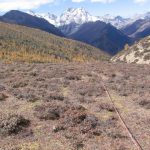Jan 2013
- Land Use
Protected area conservation is dependent to some extent on the goodwill of communities living around them. This is especially true in a developing country context, where people can pose a threat because they rely on these areas for their day to day needs, such as fuelwood and food. Teri Allendorf is working to understanding how local residents value the protected areas they live near.
Aug 2011
- Biodiversity
- Conservation
- Land Use
- Remote Sensing
Dr. Oscar Cardenas is working to better understand patterns of forest change in the Sierra de Manantlan Biosphere Reserve to develop more effective management tools addressing a range of issues from biodiversity conservation to sustainable development programs and epidemiological applications.
Aug 2011
- Biodiversity
- Conservation
- Land Use
- Remote Sensing
Jodi Brandt studies mountain ecosystem succession in China. This loss of alpine pastures affects both people and biodiversity. Which factors are responsible for these changes?
Aug 2011
- Conservation
- Land Use
Landscape connectivity analysis could help to bring back the almost extinct population of European Bison in the Carpathians. Elzbieta Laszczak research on habitat connectivity indicates where to fill the gaps for successful connection of different bison herds thereby reducing inbreeding.
Jul 2011
- Biodiversity
- Conservation
- Land Use
- Remote Sensing
Eugenia Bragina has started an exciting new project to understand land cover changes in and around nature reserves in Russia, and how these changes affect wildlife populations.
Jul 2011
- Biodiversity
- Conservation
- Land Use
Across the US, hundreds of wildlife refuges conserve migratory birds, endangered species and their habitats. However, their relative pristine nature also attracts development and that may hamper the very conservation goals the refuges were designed to achieve.
Jul 2011
- Conservation
- Land Use
- Remote Sensing
If poverty leads to deforestation in Mexico, can we prevent deforestation by paying landowners to sustainably manage forest? Carlos Ramirez Reyes is trying to answer this question using remotely sensed data.
Nov 2010
- Biodiversity
- Conservation
- Land Use
- Remote Sensing
Sarah Carter has been working on Wisconsin conservation issues for more than 10 years. Her current project asks how we can identify conservation priorities in some of Wisconsin’s most treasured landscapes, including the Baraboo Hills and the Northwest Wisconsin pine barrens.
Nov 2010
- Conservation
- Houses & WUI
- Land Use
Could land use change threaten the US National Wildlife Refuge System? PhD student Chris Hamilton uses cutting-edge technologies to find an answer.
Sep 2010
- Birds
- Land Use
Understanding how spatial patterns of vegetation explain the distribution of organisms is a central theme within Landscape Ecology. Avi Bar Massada developed a novel method to quantify these patterns, which may be more effective than existing methods. He illustrates its effectiveness with bird data from Wisconsin’s Fort McCoy.










